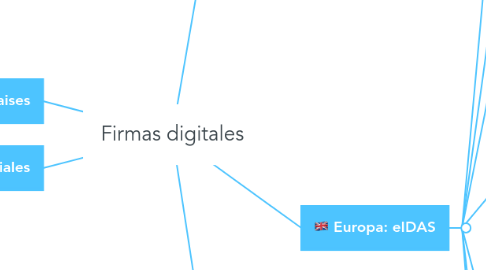
1. 🇬🇹 Guatemala
1.1. Empresas autorizadas/Proveedores
1.1.1. Firma-e Guatemala
1.1.1.1. Firma digital avanzada
1.1.1.2. API de integración de firma
1.1.1.3. Gestión documental
1.1.2. Prisma Registro Digital
1.1.2.1. InfileSign
1.1.2.1.1. Lo hacen a través de Prisma
1.1.2.2. Ingesis
1.1.2.3. Itligencia, S.A.
1.1.3. Transacciones y transferencias, S.A.
1.1.3.1. Firma digital 5b
1.2. Tipos de firma digital avanzada
1.2.1. Firma de Persona Individual
1.2.2. Firma de Profesional Titulado
1.2.3. Firma de Relación con Entidad
1.2.4. Firma de Funcionario Público
1.2.5. Firma de Representante Legal
1.2.6. Firma de Persona Jurídica
1.3. Marco Legal
1.3.1. Decreto No. 47-2008
1.3.2. Acuerdo Gubernativo No. 135-2009
1.3.3. Acuerdo Gubernativo No. 262-2009
1.3.4. Reforma al Acuerdo Gubernativo No. 109-2010
1.3.5. Acuerdo Gubernativo No. 460-2011
1.4. Normas técnicas
1.4.1. Inscripción para ser prestador de servicios de certificación
1.4.2. Guía de evaluación
1.4.3. Guía de inspecciones períodicas
1.5. Acreditaciones relacionadas
1.5.1. Registro de prestadores de servicios de certificación
1.5.2. ISO/IEC 27001
1.5.3. ISO 9001
2. Europa: eIDAS
2.1. EIDAS
2.1.1. Electronic Identification
2.1.2. Authentication
2.1.3. Trust Services
2.2. Reglamento para simplificar y estandarizar las firmas y los ID digitales por toda Europa para ayudar a crear un “mercado digital único”.
2.3. EU was governed by Directive 1999/93/EC
2.4. The eIDAS Regulation provides for a broad definition of a standard ‘electronic signature’ without any reference to a specific technology.
2.4.1. Should be technology-neutral and that the legal effects it grants should be achievable by any technical means (provided that the requirements of the Regulation are met).
2.4.1.1. Criteria 1: The existence of ‘data in electronic form’
2.4.1.2. Criteria 2: Attached to or logically associated with other data in electronic form’
2.4.1.3. Criteria 3: Used by the signatory to sign
2.5. Reglamento (UE) n ° 910/2014 del Parlamento Europeo y del Consejo relativo a la identificación electrónica y los servicios de confianza para las transacciones electrónicas en el mercado interior y por la que se deroga la Directiva 1999/93/CE
2.6. El eIDAS reconoce tres tipos de firmas electrónicas
2.6.1. 1. Firmas electrónicas
2.6.2. 2. Firmas electrónicas avanzadas (AdES)
2.6.3. 3. Firmas electrónicas cualificadas (QES)
2.7. Recommended links
2.7.1. Understanding eIDAS
3. Estados Unidos: ESIGN
3.1. Uniform Electronic Transactions Act (UETA).
3.1.1. UETA has been adopted by 47 states, the District of Columbia, Puerto Rico, and the U.S. Virgin Islands. However, three states—Illinois, New York, and Washington—have not adopted UETA, but have implemented their own statutes pertaining to electronic signatures.
3.1.1.1. In all states that have adopted UETA, the law generally does not apply to birth, wedding, or death certificates and wills, codicils, and testamentary trusts are also often exempt.
3.1.1.2. The state of Illinois (IL) has not adopted UETA. However, in 1999, Illinois enacted electronic signature law 5 ILCS 1 75/1-101.
3.1.1.3. The state of New York (NY) has not adopted UETA. However, since 2000, electronic signatures have been legally binding in New York under the Electronic Signatures and Records Act (ESRA).
3.1.1.4. The state of Washington (WA) has not adopted UETA. However, Washington did enact the Washington Electronic Authentication Act to facilitate e-commerce and minimize fraud, as well as to ensure the security and integrity of “e-messages.”
3.1.2. Features
3.1.2.1. 1.A record or signature can’t be denied legal effect or enforceability simply because it’s in electronic form.
3.1.2.2. 2. A contract can’t be denied legal effect or enforceability simply because an electronic record was used in its formation.
3.1.2.3. 3. If a law requires a record to be in writing, an electronic record satisfies the law.
3.1.2.4. 4. If a law requires a signature, an electronic signature satisfies the law
3.2. Types of electronic signatures
3.2.1. Electronic signature (e-signature) refers to any electronic process that indicates acceptance of an agreement or record. Most electronic signature solutions in the U.S. fall into this broad category.
3.2.2. Digital signature uses a certificate-based digital ID to authenticate a signer’s identity.
4. Legislación en otros paises
4.1. Country by country summaries of law and enforceability
5. Proveedores mundiales
5.1. Adobe Sign
5.1.1. Features
5.1.1.1. Cloud solution
5.1.1.2. Signature process
5.1.1.3. Authentication
5.1.1.3.1. Adobe Sign ID
5.1.1.3.2. Adobe ID
5.1.1.3.3. Google Gmail and Google Apps
5.1.1.3.4. Single sign-on using SAML
5.1.1.4. Document certification
5.1.1.5. Audit trail
5.1.1.6. Digital signatures
5.1.1.7. Cloud security
5.1.1.8. Subscription plans
5.1.2. Compliance with eIDAS
5.1.2.1. Data in electronic form
5.1.2.2. Attached to or logically associated with other electronic data
5.1.2.3. Used by the signatory to sign
5.1.3. AdES with Adobe Sign
5.2. Docusign
5.3. Yousign
5.3.1. Solo Europa
